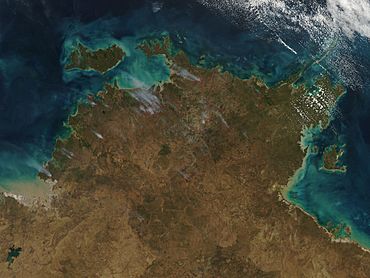Top End facts for kids
Quick facts for kids Top EndNorthern Territory |
|||||||||
|---|---|---|---|---|---|---|---|---|---|

Wetlands in Kakadu National Park
|
|||||||||

A NASA satellite image of the Top End
|
|||||||||
| Area | 245,000 km2 (94,595.0 sq mi) | ||||||||
| Time zone | ACST (UTC+09:30) | ||||||||
|
|||||||||
The Top End is a special part of Australia's Northern Territory. It's the northernmost tip of the continent, except for the Cape York Peninsula. This area covers about 245,000 square kilometers (95,000 sq mi). It stretches from Darwin, the capital, all the way to Arnhem Land.
To its west is the Indian Ocean. The Arafura Sea is to the north, and the Gulf of Carpentaria is to the east. To the south, the land becomes very dry. This dry area is often called the Red Centre. The huge Kakadu National Park is also found here.
The Top End is home to the Northern Territory's two main cities. These are Darwin and Palmerston. The important town of Katherine is also in this region. Another well-known town, Alice Springs, is much further south. It is in the dry southern part of the Northern Territory.
The land in the Top End is mostly flat. You'll find river floodplains and grasslands here. Many eucalyptus trees grow across the landscape. There are also rocky areas and small patches of rainforest. In western Arnhem Land, there's a high, rugged sandstone plateau. This plateau has deep gorges cut into it. Much of this amazing area is part of Kakadu National Park.
Important rivers like the South and East Alligator Rivers flow through the wetlands. The Mary River and the Glyde River are also here. The climate is tropical, meaning it has a wet season and a dry season. This region gets the most rain in northern Australia. It can receive over 1,200 millimeters (47 inches) of rain each year. Temperatures stay pretty steady throughout the year.
Many islands are located off the Top End coast. These include the Tiwi Islands, which are Bathurst Island and Melville Island. Groote Eylandt is another large island. There are also many smaller islands scattered around.
Plants of the Top End
Most savanna grasslands in Australia are used for farm animals. But in the Top End, huge areas of grassland are still wild. These grasslands are dotted with Darwin stringybark and Darwin woollybutt eucalyptus trees. This makes them a very special and important natural area.
The sandstone plateau in this region is rich in different kinds of plants. It has a unique heathland flora. Much of the Top End is part of the Arnhem Land tropical savanna ecoregion. To the south, this area slowly changes into drier lands. These include mulga scrubland, mallee areas, and sand dunes. This change is gradual, so there isn't a clear line between the Top End and the central dry areas.
Amazing Animals of the Top End
This region is home to many unique animals. The rivers and estuaries are full of saltwater and freshwater crocodiles. You can also find bull sharks, sawfish, and dugongs here.
The wetlands are a vital home for many birds. They are especially important for birds that migrate. The world's largest group of magpie geese breeds here. There are also many rodents and snakes.
Some animals are found only in the Top End. These include the Woodward's wallaroo, the Oenpelli python, and the Chestnut-quilled rock pigeon. The Arnhem Land rock rat and several types of skinks also live here. Other reptiles include frill-necked lizards and large monitor lizards, which locals call goannas.
Many different snakes live in the Top End. Examples are the olive python, the death adder, the mulga, and the water python (Liasis fuscus). The plateau area is home to many of these unique animals. This is especially true for invertebrates, fish, and frogs. For example, hundreds of different ant species live here. The islands off the coast also have special types of some of these animals.
Protecting the Top End
The landscape of the Top End is well looked after. Most of the area is managed by Aboriginal land trusts. This includes Kakadu National Park, which is Australia's largest national park. It is also a World Heritage Site.
Even though some animal populations have gone down, no major animal species have completely disappeared from this area. However, Darwin is a growing city. Farming and mining also happen here, and these activities can threaten natural habitats.
Animals and plants brought in from other places are also changing the environment. For example, water buffalo are affecting natural habitats. There have also been discussions about how local people manage bushfires. Large areas are burned each year to help the plants grow back.
See also
 In Spanish: Top End para niños
In Spanish: Top End para niños


